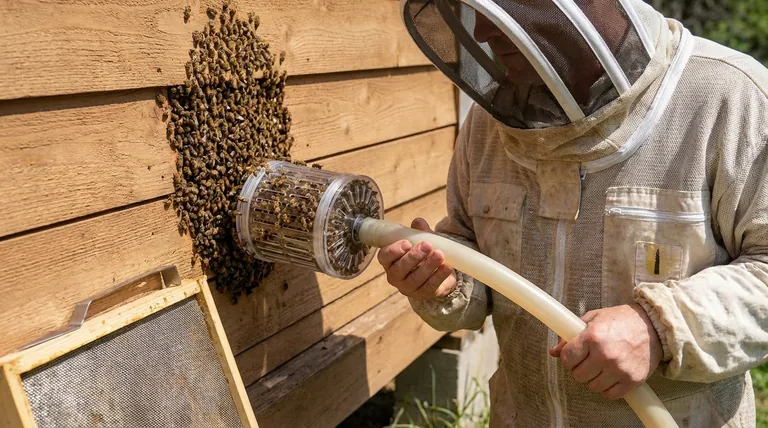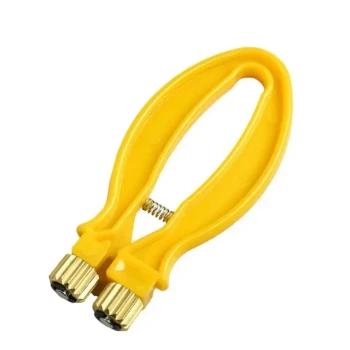When used correctly, a well-designed bee vacuum is an effective and surprisingly safe tool for relocating honey bees. The primary goal of a bee vacuum is not to harm the bees but to gently move them from an inaccessible location, such as inside a wall, into a secure and ventilated collection box with minimal stress or injury.
The safety of a bee vacuum is not inherent to the tool itself, but is almost entirely dependent on two factors: the quality of the equipment and the skill of the operator. The risk of harm comes from excessive suction power or inadequate ventilation, not the concept of vacuuming bees.

How a Bee Vacuum Works to Protect Bees
Understanding the mechanics of a proper bee vacuum reveals why it is designed for safety. It operates on principles that are fundamentally different from a standard shop or household vacuum.
The Principle of Low-Pressure Airflow
A bee vacuum does not use powerful, high-speed suction. Instead, it creates a gentle, low-pressure stream of air that is just strong enough to lift and carry a bee through a smooth-walled hose. The goal is to guide them, not to violently pull them.
The Critical Role of the Collection Chamber
The bees are not sucked into a bag or against a filter. They are drawn into a large, empty chamber—often a specially modified hive box—where the airflow dissipates immediately. This allows the bees to gently drop onto the floor or join the growing cluster inside.
Ensuring Adequate Ventilation
The collection chamber must be extremely well-ventilated. As bees are collected, they generate significant heat and carbon dioxide. Without proper airflow through the box, the bees can quickly overheat and suffocate, which is a leading cause of harm in poorly designed or improperly used systems.
Understanding the Trade-offs and Risks
While a bee vacuum is a superior tool for many situations, it is not without risks. Operator error or poor equipment can turn a rescue mission into a disaster.
The Danger of Excessive Suction
Using too much suction is the single greatest risk to the bees. It can cause physical trauma, tear wings, and slam bees against the inside of the hose or collection box. The suction should be adjustable and set to the absolute minimum required to move the bees.
Post-Capture Care is Non-Negotiable
Even after the vacuum is turned off, the risk is not over. The collected bees must be kept cool and out of direct sunlight. Providing them with a source of sugar water can help reduce stress after the ordeal of being relocated.
Acknowledging Minimal Casualties
Even with perfect technique and equipment, a very small percentage of bees may not survive the process. However, this number is typically minuscule compared to the alternative of extermination or the colony's death if left in an unsuitable location. A bee vacuum allows for the preservation of the queen, the brood, and the vast majority of the colony's workforce.
Comparing Alternatives: The Bee Brush
For different tasks, other tools are more appropriate. The bee brush is a common tool in a beekeeper's kit, but it serves a very different purpose.
When to Use a Bee Brush
A bee brush, with its long, soft bristles, is used for gently nudging bees off a honeycomb frame during a routine hive inspection. Its purpose is to move a small number of bees a few inches without causing alarm, allowing the beekeeper to inspect the frame.
When a Vacuum is Superior
A bee brush is completely impractical for removing thousands of bees from a wall cavity, a soffit, or a large, established swarm. For these "cutout" and removal jobs, the bee vacuum is the only viable tool for safely and efficiently capturing the entire colony for relocation.
Making the Right Choice for Bee Safety
Your choice of tool should be dictated entirely by the task at hand.
- If your primary focus is a large-scale swarm capture or a cutout from a structure: A properly designed bee vacuum with adjustable suction and a ventilated capture box is the correct and most humane tool.
- If your primary focus is routine hive inspection: A simple bee brush is the standard and most effective tool for gently moving bees off a frame.
Ultimately, the safety of the bees rests not in the tool you choose, but in the care and knowledge you apply when using it.
Summary Table:
| Key Factor | Impact on Bee Safety |
|---|---|
| Low-Pressure Airflow | Gently guides bees, preventing physical trauma and wing damage. |
| Ventilated Collection Box | Prevents overheating and suffocation by dissipating heat and CO2. |
| Operator Skill | Correct suction adjustment and post-capture care are critical for minimizing stress. |
| Tool Comparison | A bee vacuum is essential for large-scale cutouts; a bee brush is for routine hive inspections. |
Ensure the safety of your bees and the success of your relocations with professional-grade equipment from HONESTBEE.
We supply commercial apiaries and beekeeping equipment distributors with reliable, wholesale-focused beekeeping supplies designed for humane and efficient operations. Our equipment helps you perform safe cutouts and swarm captures with confidence.
Ready to upgrade your bee removal toolkit? Contact HONESTBEE today to discuss your needs and discover how our solutions can benefit your business.
Visual Guide

Related Products
- HONESTBEE Professional Long Handled Hive Tool with Precision Cutting Blade
- HONESTBEE Advanced Ergonomic Stainless Steel Hive Tool for Beekeeping
- Professional Dual-End Stainless Steel Hive Tool for Beekeeping
- HONESTBEE Professional Multi-Functional Hive Tool with Ergonomic Wood Handle
- Premium Wood Framed Metal Wire Queen Bee Excluder
People Also Ask
- What is the hive tool used for? The Essential Multi-Tool for Every Beekeeper
- What is a hive tool used for in beekeeping? Your Essential Guide to Hive Management
- What are the features of a regular hive tool? The Essential Multi-Tool for Every Beekeeper
- What are the basic tools for beekeeping? Essential Starter Kit for Safe & Successful Hive Management
- Why do hive tools have a hole? Unlock the Secret to Efficient Beekeeping



















